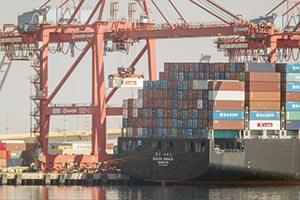Hanjin’s Stranded Cargo Begins to Flow at US Ports

This story appears in the Sept. 19 print edition of Transport Topics.
Cargo stranded by the Hanjin Shipping bankruptcy slowly began to flow through U.S. ports last week, offering the first small signs of relief for truckers and their customers.
The first few Hanjin ships to unload cargo since the Korean carrier entered receivership on Aug. 31 docked last week at U.S. ports on the East and West coasts, starting a flow of loaded and empty boxes while other freight remained stuck somewhere, often on chassis that were reported to be in short supply.
“Everybody is trying like crazy to get as many empties into [Hanjin’s Long Beach, California, terminal],” said Fred Johring, president of Golden State Logistics, at the same time that drivers are moving boxes from Hanjin’s Greece and Boston containerships. All of their cargo should be moved off the docks this week he said.
He told Transport Topics on Sept. 14 that while the Hanjin cargo pickup-and- delivery process “is going pretty smoothly from the trucker’s point of view,” carriers still have significant concerns.
“The residual issue that [truckers] have is what to do with the boxes and chassis we have,” said Johring, also chairman of the region’s Harbor Trucking Association.
Weston LaBar, executive director of the Harbor Trucking Association, said an estimated 5,000 to 8,000 Hanjin containers were stuck somewhere — on vessels, in terminals, on chassis or stacked in a yard — before cargo began to flow through Southern California, where more than half of Hanjin’s cargo enters the United States. At press time, there was no gauge of how many of those boxes were moving.
“There are still a lot of unknowns,” LaBar said, adding the situation “remains very fluid.”
LaBar believes thousands of chassis are idled, mounted with Hanjin boxes as depots that are taking in leased containers are full.
“It’s a promising step that cargo is beginning to move,” said Jessica Dankert, senior director of retail operations at the Retail Industry Leaders Association. “There is still a lot of uncertainty. The chassis issue is particularly concerning. There is still a lot of uncertainty about cargo that is in limbo and what happens next.”
She likened empty Hanjin boxes to a “hot potato,” saying that “nobody wants to handle them.”
While cargo was starting to move, industry experts said the failure of the world’s sixth-largest shipping company has triggered extensive payment and liability issues.
One such concern was the prices terminal operators were charging to release containers.
“There continue to be concerns about charges to beneficial cargo owners to move Hanjin-related cargo,” Jonathan Gold, a vice president at the National Retail Federation, told TT. “The Federal Maritime Commission has received numerous complaints and continues to work through them.”
A spokesman for the federal agency said it continues to receive comments about the Hanjin situation, including more than 40 under review by FMC staff. In addition, Chairman Mario Cordero has discussed issues with shippers through conference calls and posted a tweet saying FMC will ”vigilantly guard against those who seek to take financial benefit.”
Craig Helmreich, an Indianapolis-based transport attorney, said port terminals are charging in the $300-to-$600 range to release cargo, double or triple their typical rates.
The court process also is unfolding with limited clarity.
“We are still very much in the reactive stage. Everybody has been clamoring for some guidance from the court,” said Richard Furman, a New York maritime attorney who spoke Sept. 14 on an Air Forwarders Association conference call. He used the same “fluid situation” phrase that LaBar did.
Furman said he believes the U.S. Bankruptcy Court will defer to Korean courts on bankruptcy-related issues and noted that U.S. Bankruptcy Judge John Sherwood, for the District of New Jersey, so far hasn’t set guidelines for handling Hanjin bankruptcy issues. He ruled initially that creditors can’t seize or freeze Hanjin assets in the United States. However, the ruling isn’t yet final. Sherwood’s preliminary ruling has been challenged by some shippers and creditors.
Furman estimated that there are as many as 14 vessels whose ability to deliver U.S.-bound is still uncertain, though four have been allowed to dock. One of the stuck ships was seized in Panama, Furman said.
It is clear, he said, that Hanjin isn’t arranging any moves beyond port terminals, leaving shippers to find truckers to move the goods.
Many sources said that exports that Hanjin was supposed to move are being handled by other ocean carriers without disruption.
Johring also said the Hanjin-related market dislocation hasn’t affected Golden State as much as the protracted labor contract-related cargo slowdowns that led to prolonged congestion last year.
“As far as the driver is concerned, nothing has changed” due to Hanjin, Johring said. “We are just busy, and trying to communicate with customers to keep them up to date.”

